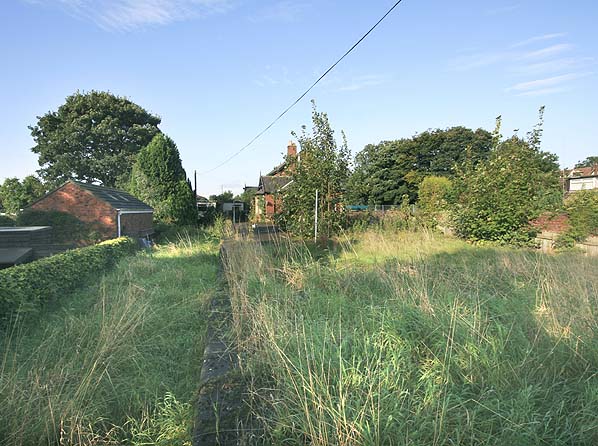
Station Name: FORGE VALLEY
|
| Date opened: | 1.5.1882 |
| Location: | West side of Garth End Road |
| Company on opening: | North Eastern Railway |
| Date closed to passengers: | 5.6.1950 |
| Date closed completely: | 5.6.1950 |
| Company on closing: | British Railways (North Eastern Region) |
| Present state: | The station is now a council depot and the main station building goods shed and platform and sheep dock are all extant although the track bed has been partially infilled up to platform level. At some time the station buildings have been divided into offices and living accommodation. The house is currently empty and appears unused. |
| County: | Yorkshire |
| OS Grid Ref: | SE986845 |
| Date of visit: | 7.9.2008 |
Notes: There is no town or village of Forge Valley and the station actually served the village of West Ayton. The station was named after a local beauty spot and it has been suggested was so named to avoid confusion with the North Eastern's Great Ayton Station. The goods yard consisted of two sidings, one with a loop on the down side of the line alongside the station. One siding served a horse dock and coal drops the other ran through a substantial brick goods shed followed by a sheep dock. Just west of the goods yard a short private siding served a timber yard.
Following the withdrawal of the Bill the North Eastern Railway were quick to step in promoting their own line from Pickering but instead of running up the Forge Valley this line would continue eastwards to join the Scarborough - Malton/Bridlington line at Seamer three miles miles south of Scarborough. Having received their Act the North Eastern Railway were in no hurry to build the line which eventually opened to the public on 1st May 1882.
Intermediate stations were built at Forge Valley (serving East and West Ayton), Wykeham, Sawdon, Snainton, Ebberston (Wilton until 1903) and Thornton Dale. Trains ran between Pickering and Scarborough, also calling at Seamer which had opened with former York and North Midland route to Scarborough in 1845. The line retained the earlier name of the The Forge Valley Line, it was single track throughout with a passing place at Snainton, the only station with two platforms running for 1614 miles from Seamer Junction to Mill Lane Junction south of Pickering where it joined the NER's lines from Rillington and Bishophouse Junction on the York - Darlington main line.
Wykeham had facilities to deal with livestock, and such agricultural produce comprised most of the freight on the line, although there was also stone from a quarry at Thornton Dale. During 1935, the first diesel-electric Sentinel Railcar, the 'Tyneside Venturer', operated a circular route via Scarborough, Whitby, Goathland and back to Scarborough along the Forge Valley line. Despite their unreliability the railcars remained in use for 20 years but were gradually taken out of service on the approach to nationalisation In June 1933 the LNER introduced camping coaches at a number of scenic stations in the area, two of these eventually came to the Forge Valley line with a single carriage being provided at Forge Valley and Thornton Dale.
local objections the line was closed from 5th June 1950; the last train out of Scarborough was at 6.40 pm on Saturday 3rd June where a small crowd gathered with over 100 local people boarding the last train which was greeted by detonators at each station. The track between Seamer and Thornton Dale was lifted between 1952 and 1953. The final three miles of the line between Thornton Dale and Pickering remained open until 10th August 1964 to serve the stone quarry. All the stations were of similar construction with substantial brick buildings incorporating the stationmaster's house. All the buildings and platforms survive and that at Ebberston which was restored in 1998 with a short section of track and three new camping coaches, ex BR 1st class stock built in 1968/9. To see other stations on the Forge Valley Railway click on the station name: Seamer, Wykeham, Sawdon, Snainton, Ebberston & Thornton Dale See alto other local lines: Malton & Driffield Junction Railway, Thirsk & Malton Railway (Malton - Pilmoor) & Gilling - Pickering |
old1.jpg)
Copyright picture from John Mann collection

old2.jpg)
valley1.jpg)
Photo by Alan Young
valley9.jpg)
Photo by Ben Brooksbank

Photo by Nick Catford
| Last updated: Thursday, 18-May-2017 11:58:21 CEST |
© 1998-2008 Disused Stations
|




valley8.jpg)
old_thumb3.jpg)






 Home Page
Home Page